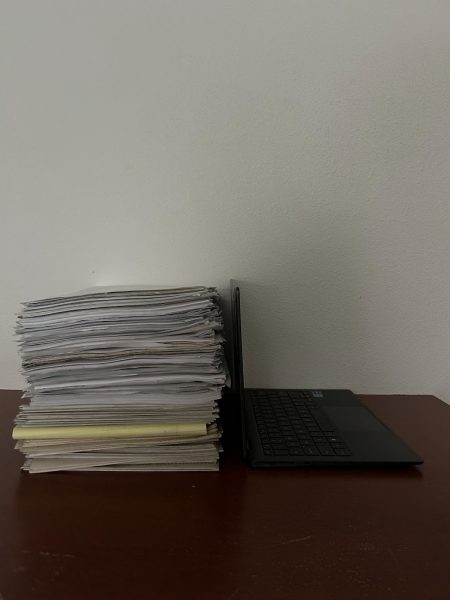
In the 2023-24 school year, high school students saw the SAT completely change to a digital adaptive test. Now, in the 2024-25 school year, students will be the first to take 28 fully or partially digital Advanced Placement (AP) tests. The transition to digital testing has resulted in many questions from students and teachers about the implementation and positive or negative effects.
The SAT transitioned to a digital testing format in March 2024. According to an article about the digital test from College Board, the transition was sparked by the need to make the test more secure against cheating attempts. This new version was also designed to be less stressful for students. To do this, College Board shortened the test by an hour, made reading passages shorter, and allowed students to have a calculator for both math sections.
College Board announced on Jan. 25, 2024, that the fall 2023 pilots of the test were not only easier for students to take, but also easier for proctors to administer. The Digital SAT also comes at a time where SAT scores hold less weight in your college applications. The number of college applicants submitting SAT or ACT scores plummeted from 76% in the 2019-2020 admissions cycle to 45% in the 2023-2024 admissions cycle, according to the New York Times. This drop was also largely due to the COVID-19 pandemic making numerous colleges go test-optional, meaning students’ SAT scores would not be considered in the admissions process.
This is not the first time students have seen tests that were once regulated to pen and paper switched to digital. During the COVID-19 pandemic, more than 4.2 million students took their AP tests online. However, these tests were heavily modified to be easier for AP students. For example, they eliminated all multiple choice questions (MCQs), opting for just free response questions (FRQs). This decision shortened the test time from two to three hours to just 50 minutes.
When students returned to in-person learning, the AP tests returned to the previous length, difficulty, and format. On July 25, 2024, the AP Program announced that 28 courses would be transitioning to fully digital or partially digital exams. They explained that this switch will streamline the pre-test process, be more accessible for students on the Bluebook software, and is more “student-friendly.” This switch is also due to the increased amount of cheating attempts and exam cancellations in recent years.
In May 2025, 16 exams will go fully digital. The majority of the courses going fully digital are AP English and history courses, along with a few science courses such as environmental science and computer science. Along with 16 fully digital exams, students can expect to see 12 “hybrid” or partially digital exams. These exams consist completely of science and math exams, for example, calculus, physics, and chemistry.
There are only eight exams that will continue with paper tests this year. These eight are every AP language test and AP Music Theory. Despite being in-person this year, College Board did announce that these exams will transition to the Bluebook software in the future.
“We understand that this is a significant change, and we will work closely with the AP community throughout the year to ensure that schools have the information and resources they need to prepare for digital AP Exams,” College Board stated in an announcement. These resources include free online practice exams and quizzes and test previews for all subjects on Bluebook at the start of the 2024-2025 school year.
Franklin is home to numerous AP teachers, but none more renowned than Elisa Wong. Wong has been teaching AP classes since 2007 and teaching at Franklin for ten years. This year, Wong will teach AP Language and Composition, as well as AP Seminar. The AP Language test is three hours long and consists of 45 multiple choice questions and three essays. However, the AP Seminar test consists of uploading a digital portfolio and completing a two hour test. “In the past, I’ve been able to get anywhere between 85 and 95 percent of students to take the exam,” Wong stated. She also revealed, with the paper tests, “I’ve always gotten really good pass rates, [and] I think students come back feeling pretty good.” This year, Wong will have to adapt parts of her teaching in order to prepare students for the online versions of their test.
Along with many other teachers, Wong questioned the “equity of typing classes across the district, and if every student is a fast typist.” She believes that AP teachers will really have to focus on getting students ready to type things out in the spring. “I still think there is so much to be gained from handwriting at first and … I’m still going to focus on that, and then in the spring I’ll switch gears … to typing [FRQ’s],” Wong explained.
Another influential AP teacher at Franklin is Anna York, the AP Psychology and AP Research teacher. When it comes to proctoring the Digital SAT, York explained, “For the teachers, it went better, … there were less moving parts for us to have to worry about.” In the past, “when we are asked to proctor, it’s really stressful for us, because we want to make sure it’s done correctly, so that we can give students the best chance,” York said.
York also sees the positive in typed responses, as it may help with the scoring process. “I did have several students last year whose handwriting was very difficult to read,” she explained. When it comes to scoring AP tests, scorers do not have the ability to ask the student what they wrote if it is unclear as AP teachers can during the year. So, York agreed that typed responses will help to ensure students’ points and words are being fully understood by readers.
However, along with Wong, York agrees that there are some unknowns for teachers when it comes to teaching to a digital test. York revealed that she is “not exactly sure how I am going to have students do test revisions,” when all papers and FRQs are typed out. The digital component, York said, “also makes [students and teachers] really reliant on AP Classroom … which can be kind of confusing for some families.”
At Franklin and in Portland Public Schools, there are still many questions regarding the digital AP tests. The most significant one is the question of where AP testing will be held in May. Many teachers, like Wong, have theorized that it will be held at the vacant Marshall Campus. Others believe that it will return to the convention center.
Wherever testing is held, it is important that there is good Wi-Fi. This is important so that all students can begin the test. However, College Board has made it so that both the SAT and AP tests are designed to not be affected if Wi-Fi fails midway through the test. Another important piece of information is that the Bluebook testing software, used for both the SAT and AP tests, will allow students to test on personal or school issued computers.
When it comes to student perspectives, College Board claimed, “Students like the Bluebook … [as it] helps them focus on the relevant parts of longer reading passages; enables faster writing and editing compared to handwriting; and provides a less stressful testing experience.” Unfortunately, this claim is not supported by every student; many believe that digital testing is more difficult, especially when it comes to reading and annotating passages.
Piper Powell, a senior at Franklin, shared her thoughts on the pros and cons of digital tests. She explained that she prefers paper tests because “I really do like to have marked up the text and I feel like I’m faster if I am on paper.” Powell continued, and said, “I am a little nervous that I won’t be as thorough in reading but I do think I can be pretty fast at typing, but I don’t know that everyone has that skill.” Despite these concerns, Powell believes that digital tests also have some positive aspects. She explained that faster score delivery on the SAT and less environmental waste are major pros when it comes to this new style of testing. Powell also shared that compared to the PSAT, which she took on paper, the Digital SAT “felt like it was faster and the calculator on the math section was a good tool to have on hand.”
When it comes to digital testing, I believe it has a balanced amount of pros and cons. On one hand, I love being able to annotate and mark up a paper text with little notes. On the other hand, I won’t miss the horrible hand cramps that come with handwriting multiple essays in a short period of time.
It’s clear that digital tests are here to stay and will likely alter teaching, learning, and studying methods. I do not doubt that the first round of digital AP exams will prove to be intriguing, much like the first Digital SAT tests. However, I believe that through trial and error over the next few years, digital testing softwares will prove to be extremely beneficial for students and teachers alike in the future.


































